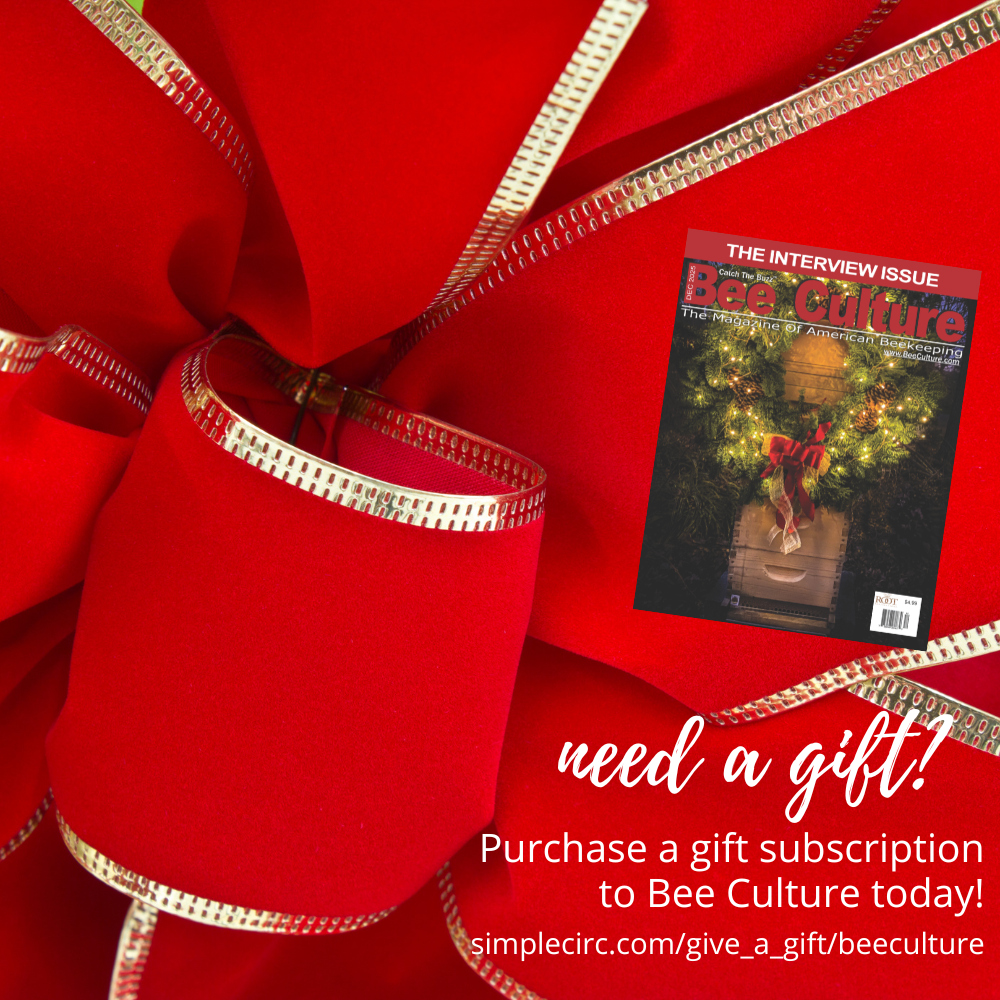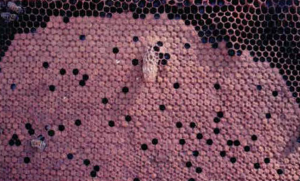By: Ann Harman
This article originally appeared in the Spring 2017 issue of BEEKeeping Your First Three Years
January is a quiet month for actual beekeeping unless you are a big commercial pollinator. Then you are getting your bees ready to travel to their first crop. No matter where you live the queen will be increasing egg laying in preparation for Spring. Just when does Winter become Spring? Well, that depends on where you live. During these months in a cold climate you are watching snowflakes flying with the Winter wind. In the warm climate of the South you are watching honey bees flying in the warm sun. So let’s leave wooly sweaters and warm gloves behind and go South to watch the bees flying and see what they are doing and consider their plans for the next three months.
If we follow the South from East to West we will find the African bee in Florida as well as our European stock bee. As we travel west we may encounter only pockets of the African bee until we reach Texas and westward. In this region the African bee is well-established. The African bee does require a different approach to beekeeping from that with European stock. More about the African bee later.
In general throughout the deep South something can be found blooming every month of the year, even if it is only the ubiquitous dandelion. Brood rearing does decrease from October into December but the queen never really stops laying. She was just not yet laying as many eggs as in the Spring months. As January arrives brood increases. Swarms can appear in February but in many places early March can be considered peak season. If you plan to collect swarms, either from your own hives or from your area, have your swarm-catching equipment ready. If this is your first swarm-catching season perhaps you can find a more experienced beekeeper to help you. Although you may be determined to catch a swarm it may not be a wise idea if it’s 35 feet up in a swaying evergreen tree. You don’t want to risk injury – your bees need you!
In some areas you will want to start looking for queen cells during February. Although these are signs that your colony is planning to swarm, you can use these queen cells to make a nuc (nucleus) colony. If you have not done this before you may wish to have a mentor help you select the frames to put in the nuc and also to remove and install the queen cell from the original colony.
At this time of year you need to be a good Plant Watcher. In these warmer areas of the country bee plants will be blooming. Have you learned what the bee plants are around you? You do need to be a member of your local beekeepers club because there is where you will find information for your locality.
Beekeeping books are good for information but some might have a bias toward the large temperate part of the United States. Here in the South, especially in Florida, the climate is approaching sub-tropical in temperatures throughout the year. General lists of garden plants for bees may need to be modified for your locality. Fortunately field guides to wildflowers indicate where various plants grow. With the help of your club members you can make your own list of pollen and nectar plants in your bees’ forage area. Maybe your club already has a useful list. There’s another good reason to belong to a local club.
The main nectar flow does depend on the area of the South. For some beekeepers in the Gulf states it can start in mid-April and continue into June. At one time large crops of honey could be made from citrus in Florida, Texas and California. However with the advent of the citrus greening disease vast acreages of citrus trees have died. So the amount of orange blossom honey has decreased. Cotton is one of the main agricultural crops and a good crop of cotton honey can be made. At one time cotton fields were heavily treated with an array of pesticides. However the cotton itself and the pesticide schedule has changed in recent years making cotton a more desirable crop for honey production.
Throughout the year colony size in the southern tier of states may not approach that of colonies in temperate and cold areas of the U.S. A common size of hive is one deep brood chamber with a medium hive body on top of that. Honey supers, of course, can be of any size you wish. Winter stores can be as low as 25 pounds of honey, quite adequate when forage is available 12 months of the year.
Since the soil in the South tends to be sandy, the small hive beetle (shb) can be a very serious pest in the eastern part. The sparse rainfall of the desert part of the southern states does not provide the damp soil necessary for the beetle’s pupation. So the desert areas, and also those with African bees, have the least problem with shb. Where shb is a problem, hives will be fitted with several beetle traps. If the hives are not sitting on the ground but are raised up on hive stands beekeepers will frequently put a trough of water under the hive entrance. As the beetle larvae exit the hive quite a number tumble into the water and drown, certainly a cheap and easy help for control. Don’t hesitate to apply your hive tool if any shb are seen during hive inspections. If you live in an area where you can keep free-range chickens, you will find they do love to hunt and eat the migrating larvae.
If this year is going to be your first honey harvest, keep the shb in mind at all times. Southern beekeepers quickly learned to pull honey supers off as soon as capped and extract immediately before shb invaded and slimed the honey. The ‘honey house’ where beekeepers will extract or otherwise harvest their honey must be kept clean. Honey is the attractant for shb so cleanliness from spilled honey is important for all stages of honey harvest.
Varroa is actually the number one pest of bees in the U.S. The problem is not so much the mite itself but the viruses it carries and transmits. With year-around brood production, even if decreased in Autumn, beekeepers need to have a plan of monitoring for varroa. The threshold for treatments is finding more than three mites per hundred bees. Monitoring can be done at any time in the South. But opportunities for treatments can be limited. The labels on your chosen miticides need to be read carefully for the safe temperature range during use. That means the entire time a product is kept in the hive. So be a Weather Watcher and keep your bees safe.
Perhaps it is time to see what is happening in Texas and westward – into African bee territory. Here you will find not only a different bee needing a different approach to beekeeping but also different climate in the desert areas with different honeys.
Let’s try to use the correct term for the African bee. It is overly defensive. Although the term aggressive is frequently applied, an African bee out foraging is no more aggressive than a European stock honey bee. The African bee is very sensitive to anything approaching the colony, whether the bees live in a beekeeper’s hive or somewhere else in a chosen ‘nest site’ that could be in a water meter cavity, an abandoned car or an unused barbecue grill in someone’s garden.
As such, keeping African bees is more ‘let-alone beekeeping’ than ‘managed beekeeping.’ They are unpredictable – one day calm, the next day very defensive. Beekeepers learn how to live with them. The African bee has a strong swarming instinct and may cast swarms at any time. The queens are prolific egg layers so if one or more swarms are cast from a colony, the bees are
replaced readily. They are also very good at absconding. If they consider something is not satisfactory with their home all the bees and queen will simply leave, abscond. Sometimes brood and food are left behind.
The African bee does respond to heavy smoking. So a big smoker and plentiful fuel are helpful.
If possible smoke entrance very well and wait a minute or two before opening a hive. That little bit of time allows them to engorge with honey and become more calm. Beekeepers in the African bee areas do produce honey, collect pollen for sale and harvest wax. The African bee can certainly be considered a good honey producer with sufficient forage. Fortunately the African bees do not tolerate small hive beetles or Varroa so those health problems are not a major concern.
Some experienced beekeepers try to keep European stock bees in African bee areas by frequent requeening. However this has two problems – constant requeening is expensive and requeening can be difficult. African bees simply do not like European queens to be introduced so an expensive European stock queen can be killed. In addition the African bee is quite clever at usurping a European bee colony. So a hive thought to be filled with European stock bees can, in time, actually be filled with African bees, much to the surprise of the beekeeper.
In Texas and westward the several species of mesquite provide a very good honey crop. Bloom depends on the area and also elevation. In general late May and early June are bloom times but later in the mountains. Texas has different climate areas and bees there do produce a variety of honeys. So it is important to know the honey plants and their bloom times in your particular area to obtain a honey crop.
If you live way up North you are probably reading a good bee book in front of a roaring fire in the fireplace. Your bees, still in Winter cluster, are making their swarm plans right now. So your busy time will come soon. Perhaps one day you might move South where you will be interacting with your bees the year around. Learn your beekeeping area of the U.S. -mits climate and its plants so you can help your bees to be healthy and productive.














